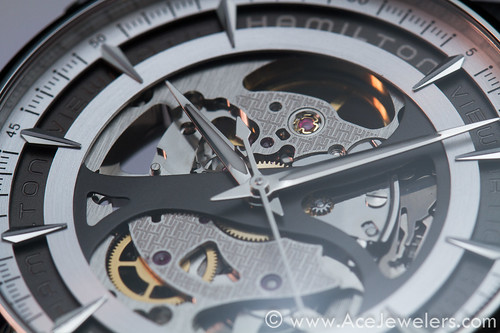Being among the entry-level brands under the aegis of the mighty Swatch Group conglomerate, Hamilton offers one of the strongest value propositions for those interested in Swiss-made mechanical movements - specifically those made by Swatch's subsidiary ETA - in the sub-$1000 price point. Last year's Hamilton Intra-Matic - featuring an ETA 2892-2 at a street price of just over $500 - is a prime example of the solid finishing and economy of scale that Hamilton can offer budget-minded mechanical watch fans.
The one design that caught my eye - supposedly revealed at BaselWorld 2013, but sneak-peaked by the good folks at Hodinkee in February - is the Jazzmaster Viewmatic Skeleton, reference H42555151. It represents a rare opportunity to acquire a skeleton movement - an even rarer (though admittedly somewhat contra-purposed) automatic one at that - with the finishing available from a large watch brand at a suggested retail of approximately $1200. Applying the usual Hamilton street discount, it's likely to become a Swiss-made skeleton model at or below $1000.
| Image courtesy Hodinkee.com. |
 |
| Image courtesy AceJewelers.com. |
As can be seen in these close-up images, the dial appears very attractively designed and well-finished for a mass-production model, with many flourishes - like the Hamilton "H" patterning on the movement plate - that can only be achieved economically by a large-scale manufacturer. The watch is sensibly sized for dress and casual use at 40mm, and satisfies my personal criteria of being time only - avoiding the annoyance of having to reset date or day windows, or the more arcane knowledge required to set moon phase complications (knowledge that I still do not possess).
While Hamilton calls the movement a Caliber H-20-S, automatic skeleton; its size relative to the case and rotor design lead me to believe it's a skeletonized form of the ubiquitous ETA 2824, albeit a variant that will be exclusive to Hamilton. (Another perk of being in the Swatch Group is access to exclusive ETA variations, which other Swatch brands like Longines have also enjoyed.)
For my watch box, the new Viewmatic Skeleton is possibly poised to knock the Intra-Matic from its place as my go-to automatic. My work responsibilities that make the Intra-Matic's date window a convenient evil will conclude at the end of June, and while I've grown to like the Intra-Matic's hour-and-minute-only hand setup, part of the soul of a mechanical movement does lie in the telltale sweep of its second hand. Only the comparatively larger size - 36mm to 38mm is really the ideal for my 6" wrist - and potential movement downgrade from a 2892 to 2824 give me pause in considering the switch. I may have to see the watch in person to make the final call.
